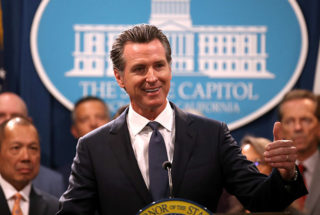Analysis: California’s state budget has big benefits for teachers union, stifles charter schools and funds phantom students
Mike Antonucci | August 10, 2020
Your donation will help us produce journalism like this. Please give today.
Students of civics might think the California state budget is crafted by the elected representatives of the citizenry, who debate and amend proposals working their way through various committees, ultimately leading to a spending plan with majority support and the signature of the governor.
All that happens, of course, but no budget makes it to the governor’s desk without at least the tacit approval of the state’s public employee unions. Since public education alone makes up a minimum of 40 percent of the state budget, the California Teachers Association has an outsized influence over the construction of that budget.
This has been true for at least the 27 years I have covered the union’s operations. In 2000, for example, then-President Wayne Johnson boasted to his members about how he had the governor and state legislative leaders on the phone with him, falling over themselves to place more money in the education budget, until Johnson finally relented at an additional $1.84 billion.
This year’s budget, however, rivals any previous examples of teacher union benefits sewn into state law.
- Imaginary money. The budget relies on two sources of funding that do not exist, and may never exist. First, it hopes that the U.S. Senate will approve, and President Donald Trump will sign, the HEROES Act, which contains $1 trillion in aid to state and local governments. Should that fail to happen, California will issue $12 billion in deferrals to school districts. Deferrals are essentially IOUs to be paid in the next fiscal year. This is also money that doesn’t yet exist.
Should deferrals become necessary, the state also authorizes school districts to transfer money from any account they hold to any other account in order to pay their bills. Money targeted for a specific purpose or program can be used for any purpose or program. Districts can also use the proceeds from the sale or lease of property for any general fund purpose.
- Funding tied to last year’s attendance. School districts are supposed to be funded according to the number of students they teach. This budget funds them according to the number of students they taught last school year. This leads to some serious inequities, as school districts with falling enrollment will receive funding for students they no longer have and districts with rising enrollment will have to teach more students with the same amount of cash.
This imbalance is especially egregious when it comes to charter schools. Unions are vocal about their desire to limit the growth of charters in the state. Overall, enrollment in the state’s public schools fell by more than 63,000 students over the past two years. Charter school enrollment grew by more than 46,500 students over the same period.
One group has already sued the state on behalf of a handful of charter schools, though a victory would also benefit those traditional public school districts with growing enrollment.
- No layoffs. Until July, California school districts cannot lay off teachers or other certified professional employees for budgetary reasons, unless that employee is an administrator or supervisor. The layoff ban includes probationary teachers. School districts are also prohibited from laying off bus drivers, custodians and food service personnel until July, including probationary employees. Aides in classroom and extracurriculars are still subject to layoff and will probably suffer the lion’s share of job losses.
- Fewer instructional minutes. The state will keep the same number of instructional days in the school year, but the number of instructional minutes per day was cut for every grade level: 20 minutes shorter for kindergarten; 50 minutes shorter for grades 1 to 3 and one to two hours for upper grades. As drastic as those cuts are, they are a significant improvement over what students received this spring. One English learner advocacy group survey revealed 76 percent of teachers said they offered less than three hours of live instruction each week after the state shut down schools in March.
- Less accountability. The California School Dashboard, though flawed, provides information on schools and districts, including academics, absenteeism, graduation and suspension rates, and college readiness. This data will not be published in 2020, and the state Department of Education will not be allowed to identify any district that is deficient on any of its measures.
Despite these major victories in the budget, the union already has its eyes on a bigger prize.
“We appreciate and recognize that this budget agreement averts immediate education cuts and thousands of educator layoffs, but without additional revenues, it also kicks difficult funding problems down the road,” said President E. Toby Boyd, before launching into a pitch for the union-backed split-roll property tax initiative, designated as Proposition 15 for the November ballot. The measure would increase taxes on many commercial properties while leaving residential property taxes at current levels.
If traditional school funding problems have been kicked down the road, the state budget will steamroll over the funding of many California charter schools. I suspect the union sees this as a feature and not a bug.
